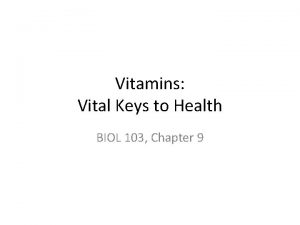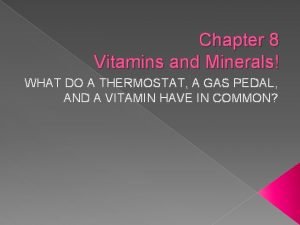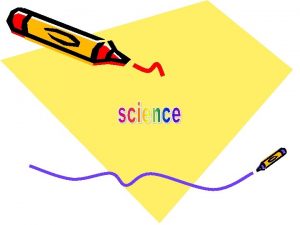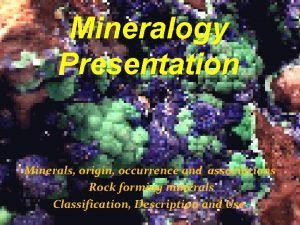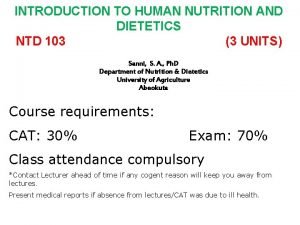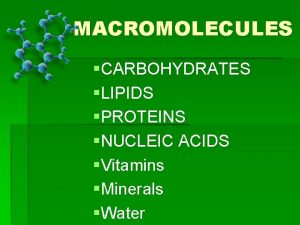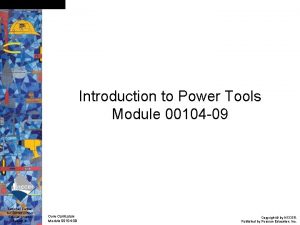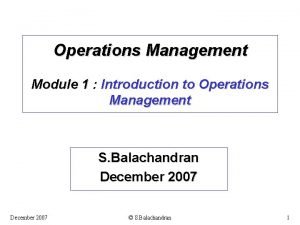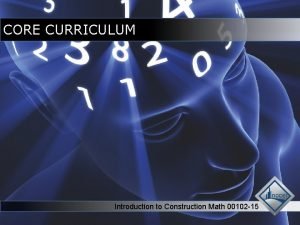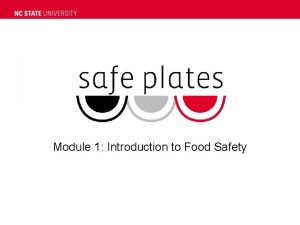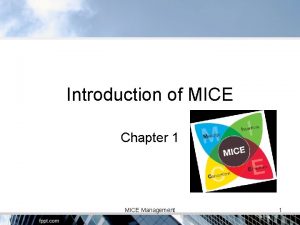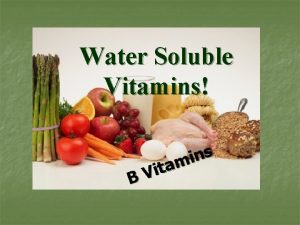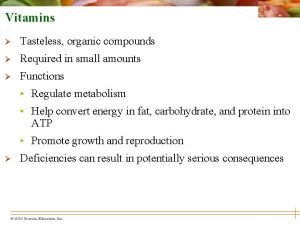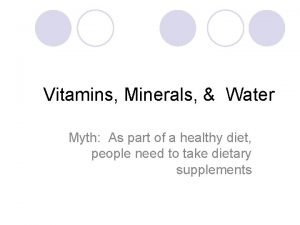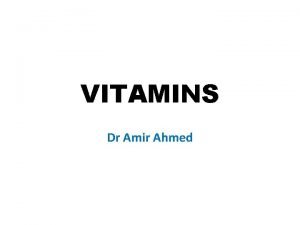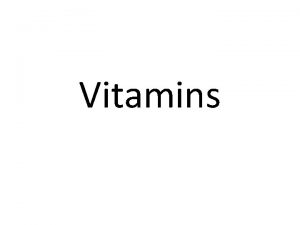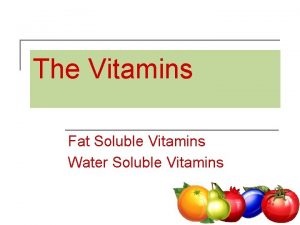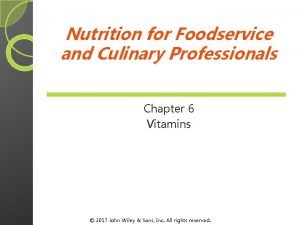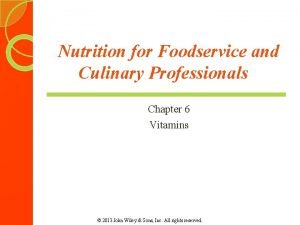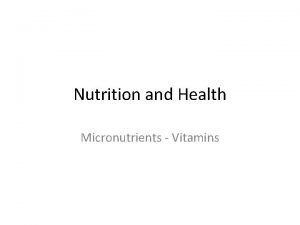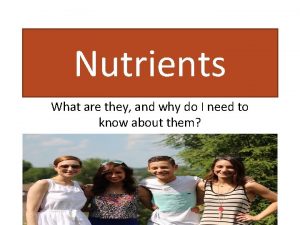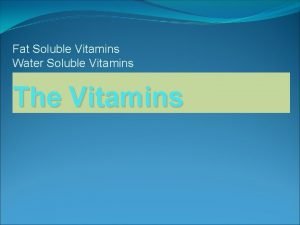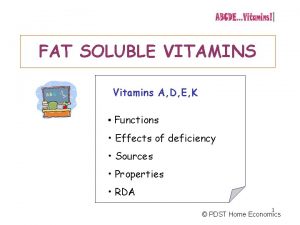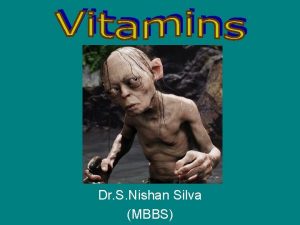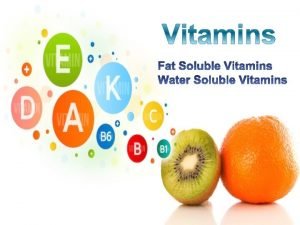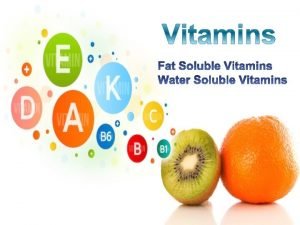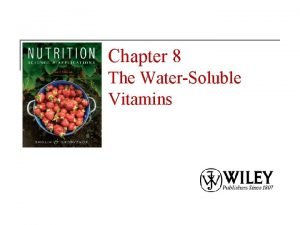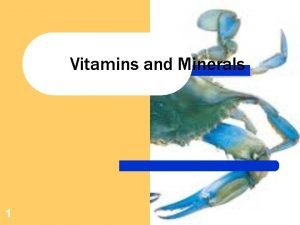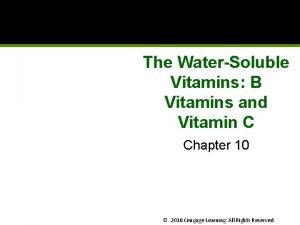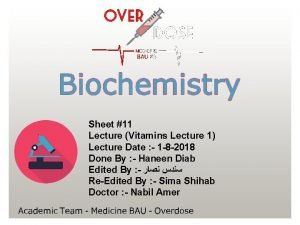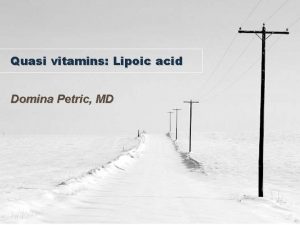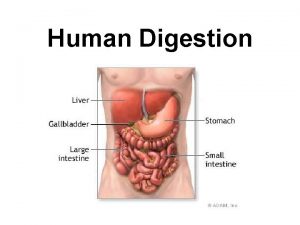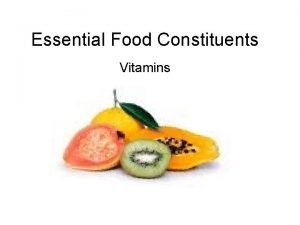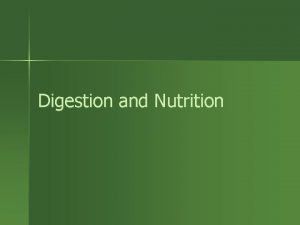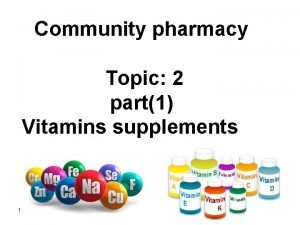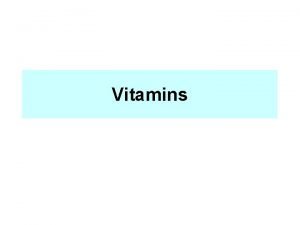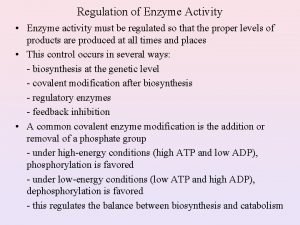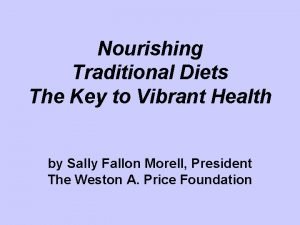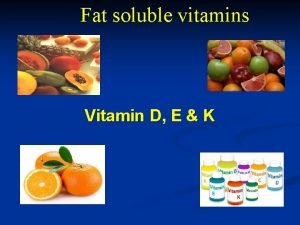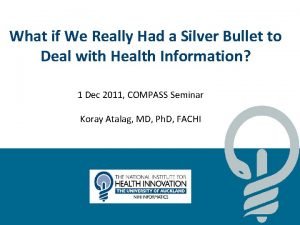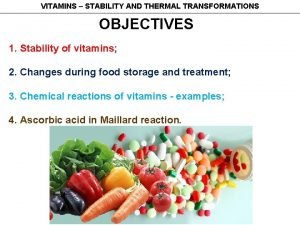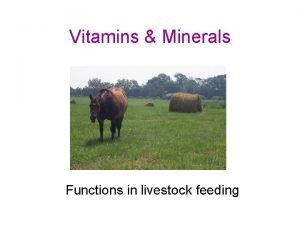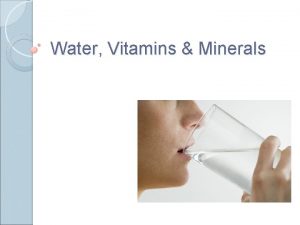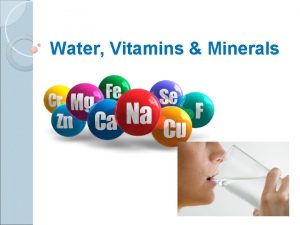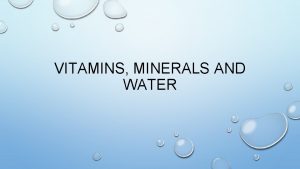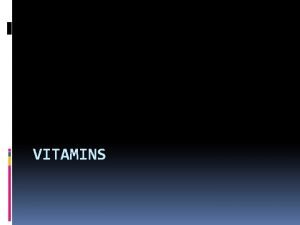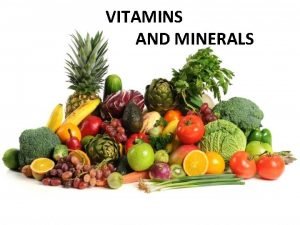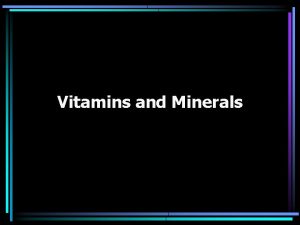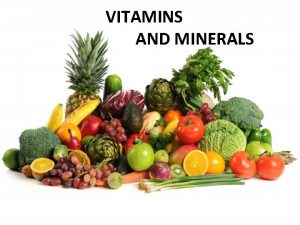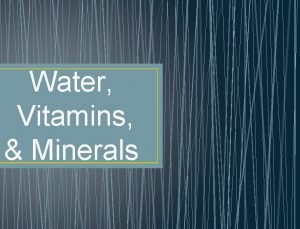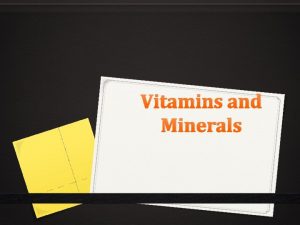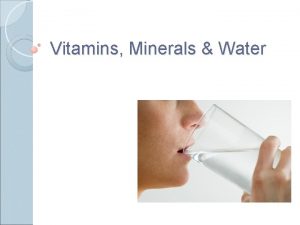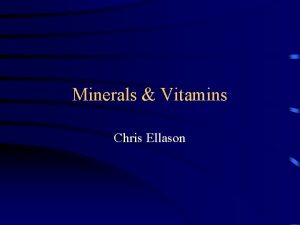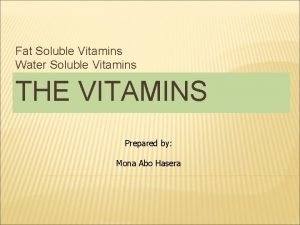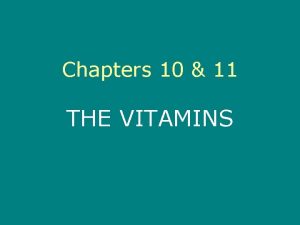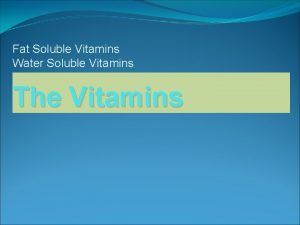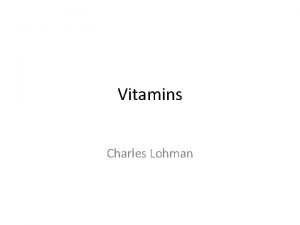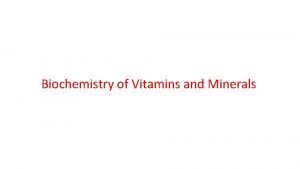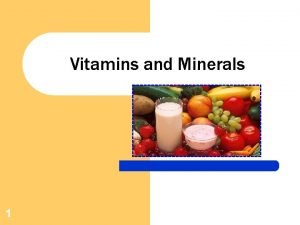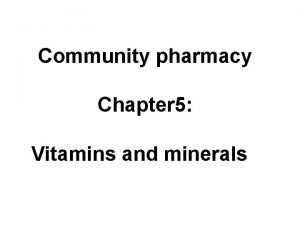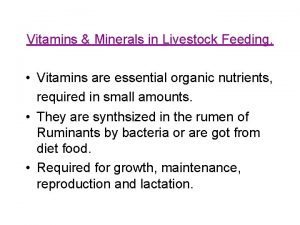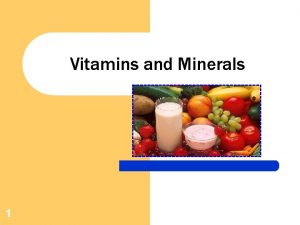The Vitamins Minerals Module 5 Introduction Vitamins Minerals









































































































- Slides: 105

The Vitamins & Minerals Module 5

Introduction Vitamins & Minerals play integral roles in cell metabolism as coenzyme or cofactors for enzymes Vitamins & Minerals are required in specific levels for normal functions Too little or too much usually results in serious health consequences

Vitamins Module 5. 1

Introduction Vitamins: are organic compounds are present in all natural foods essential for: Growth Reproduction & The maintenances of health are NON-CALORIC Needed in minute quantity Lack of any Vitamin in the diet results in specific deficiency symptoms that are relieved by its addition to the diet.

Vitamins VITAMINS FALLS INTO TWO GROUPS Vitamins have traditionally been grouped based on their solubility in water or fat

Vitamins in our Food Almost all foods contain some vitamins for example: Vitamin content of the food can be affected by: Cooking Exposure to light and Oxygen Storage and Processing The Vitamins naturally found in foods can be washed away during preparation or destroy by cooking

Vitamins in our Food FORTIFICATION: The added nutrients may or may not nave been present in the original food Food that are staples, are often fortified to prevent deficiencies and promote health Example: Milk fortified with Vitamin A&D ENRICHMENT: Is a type of fortification in which nutrients are added for the purpose of restoring those lost in processing to the same or higher level than original foods

Vitamins in My. Pyramid

FAT SOLUBLE VITAMINS

Fat Soluble Vitamins A, D, E and K are fat-soluble vitamins. Fat-soluble vitamins require bile and dietary fat for absorption. Once absorbed, they are transported with fats through the lymphatic system in Chylomicrons before entering the blood.

VITAMIN A

Vitamin A is present in three form in human body: Retinol—involve in reproduction, Bone formation and store in Livers Retinal—involve in night and color vision Retinoic Acid —involve in cell growth and cell differentiation A unit called Retinol Activity Equivalents (RAE)

Vitamin A First fat- soluble vitamin to be recognized Still very much a focus of research Vitamin A found in two forms IN PLANTS AS CAROTENOIDS –(inactive or precursors) IN ANIMALS AS RETINOIDS – (active or preformed)

ROLE OF VITAMIN A Versatile vitamin role in: Vision Gene Expression Cell differentiation Cell maturation Immune system T-Cells Epithelial Layers Maintenance of body linings & skin Bone formation Normal growth Reproduction Normal development of fetus Production of sperms

MOST FAMILIAR FUNCTION IS IN EYE SIGHT Vitamin a play indispensable role in roles in two areas In the perception of light at the retina Maintenance of a healthy & crystal clear outer window, the cornea

In advance stage of deficiency a protein keratin accumulate at cornea called keratinization. If deficiency is not corrected it can worsen to xerosis. Then to thickening & permanent blindness called xerophthalomia

VITAMIN A TOXICITY Hair loss Stunted growth Joint pain Bone & muscle soreness Cessation of menstruation Nausea Diarrhea Rashes Abdominal pain Serious damage to the liver

Vitamin A Toxicity Bone & tooth: Decreased bone mineral density Central Nervous System: Headache, vertigo GI System: Nausea and vomiting, liver abnormalities Neuro-Muscular: Incoordination Other: Retinoid embryopathy

VITAMIN A TOXICITY Pregnant women- 3 -4 time caused malformation of the fetus Children- chewable vitamins as candy Adolescents- massive vitamin A dose is a mistaken belief- correct acne. Accutane- derived from vitamin A but chemically altered.

Vitamin A: Food Sources Retinol: (animal) Fortified milk, cheese, butter, margarine Eggs Liver Beta-Carotene: (Plant) dark green leafy vegetables broccoli, deep orange fruits, & vegetables

Vitamin A in Foods

VITAMIN D

Vitamin D Different from all other nutrients- Can be synthesized in body. Also known as SUN SHINE VITAMIN

Vitamin D Activation ACTIVE VITAMIN D FUNCTIONS AS A HORMONE: Act on bones Intestine & Kidney

Vitamin D Any disease affecting either the liver or kidneys may upset vitamin D production and may lead to bone deterioration,

ROLE OF VITAMIN D Maintain blood Ca & P levels & bone integrity. When vitamin D is deficient only 10% to 15% dietary calcium can be absorbed. That cause abnormal development of bones in children. That is called RICKETS

VITAMIN D DEFICIENCY Osteomalacia or adult rickets occurs in women with low Ca intake & little exposure to sun. Repeated pregnancies & breast feeding Vitamin D also prevent from cancer such as: colon breast ovarian and prostate

Meeting Vitamin D Needs Only a few foods are natural source of Vitamin D Liver Fatty Fish such as Salmon Egg Yolk

Vitamin D in Foods

FACTORS AFFECTING SUN EXPOSURE & VITAMIN D SYNTHESIS UV Rays of sun that promote vitamin D synthesis cannot penetrate: Air pollution City living- Tall buildings Clothing Homebound Season Time of day Clouds Smoke Window glass Sunscreens

VITAMIN D RECOMMENDATION 19 - 50 years of age 5 ug 51 - 70 years of age 10 ug 71> years of age 15 ug In absence of adequate sunlight exposure requirement may increase up to: 20 – 25 ug for all TOLERABLE UPPER INTAKE 50 ug in 2000 iu

VITAMIN D OVERDOSE Most toxic of all vitamins chronic ingestion of excesses may be directly toxic to the bone, kidneys, brain, nerves, heart & arteries Raises blood mineral level to dangerous level Ca deposit in soft tissues such as: Heart Blood vessels Lungs Kidneys

VITAMIN E

Vitamin E Discovered 80 years ago in vegetable oils- Necessary for reproduction in rats. Named “Tocopherol” “Tokos” means “Off Spring” “Pherein” means “To Bear” Later on it was named vitamin E. In 1968 Vitamin E was officially recognized as an essential nutrient

Vitamin E Act as an antioxidant it protects the PUFA and other vulnerable components of the cells. Specially play vital role in tissues where cells are exposed to high oxygen concentration Lungs RBC WBC etc. Requirement of Vitamin E is proportion to PUFA in diet.

Vitamin E

Function of Vitamin E Normal nerve development Normal immune system May also defend against heart disease. Also inhibit an enzyme that allows the buildup of atherosclerotic plaque Also defend cells from damage by heavy metals, such as lead and mercury and toxins such as benzene Also protects against environmental pollutants such as OZONE

Vitamin E deficiency is rare in human Because: It is wide spread It is store in liver Recycle Vitamin E deficiency in human occurs in premature babies Without vitamin E infants RBC rapture (Erythrocyte hemolysis)- Infant become anemic

Vitamin E deficiency In adult deficiency associated with disease that cause malabsorption of fat. i. e. disease or injury of liver, gallbladder or pancreas Extremely low fat diet - Fat replacer Highly processed or convenience food Vitamin E is sensitive to Heat. Longer cooking or cooking at higher temperature can destroy all Vitamin E

Vitamin E: Food Sources Nuts Seeds Plant oils Wheat germ Fortified cereals Vegetables

Vitamin E in Foods

VITAMIN K

VITAMIN K Phylloquinone (K 1) from plant sources & Naphthaquinones (K 2, multiple forms) from animal sources & gut bacteria.

Vitamin K was named for “koagulation, ” the Danish word for coagulation. Abnormal blood coagulation is the major symptom of vitamin K deficiency. Vitamin K deficiency is very rare in the US. Key function: its role in the blood-clotting system of the body. Works with vitamin D to help regulate the calcium levels in the blood. Is obtained both in the diet and via the intestinal bacteria, making deficiencies rare.

Vitamin K Newborn babies are the one group that is commonly susceptible to a vitamin K deficiency. A baby’s digestive tract is free of bacteria until birth.

Vitamin K Requirements Unlike other fat soluble vitamins this vitamin used up quite rapidly. So a constant supply is needed. Only a small number of foods supply this vitamin. Vitamin K is synthesis by the bacteria in the intestine

Vitamin K Deficiency Rare Exceptions are: -antibiotic -new born Tolerable upper intake level- not yet set

Vitamin K Toxicity Rare Can result when supplement of synthetic vitamin K are given that may cause breakage of RBC releases the blood cell pigment (bilirubin) leads to jaundice that causes brain damage

Vitamin K: Sources Green leafy & cruciferous vegetables Soybeans Some plant oils

Vitamin K in Foods

WATER SOLUBLE VITAMINS

WATER SOLUBLE VITAMINS Thiamin Riboflavin Niacin Biotin Pantothenic Acid Vitamin B 6 Folic Acid Vitamin B 12 Vitamin C

Water-Soluble Vitamins Act as part of Coenzymes Help the body Metabolize Carbohydrates, Lipids and protein.


Coenzymes: enzyme helpers; small molecules that interact with enzymes and enable them to do their work. Many coenzymes are made from water-soluble vitamins

Roles of Thiamin (B 1) plays critical role in the energy metabolism of all cells Supports normal appetite & nervous system function Vital for NERVOUS SYSTEM Synthesis of neurotransmitters Production of sugar “RIBOSE” Needed in metabolism of certain amino acids & sugars The classic thiamin- deficiency disease “BERI. ”

BERI SEVER DEFICIENCY DISEASE IS CALLED “BARI” CAUSES: Extreme Loss of Muscles Swelling all over the body Enlargement of heart Irregular heart beat Paralysis and Death

Thiamin Beriberi is rear these days but a form of a thiamin deficiency disease occurs in alcoholic. Alcohol – impairs absorption

Thiamin B 1 - sources and Recommendations DRI 1. 2 mg/day men 1. 1 mg/day women Sources All natural foods Liver Whole grains, brown rice Legumes Nuts Fruits

RIBOFLAVIN

Riboflavin: B 2 It bright fluorescent yellow color product That make urine color bright fluorescent yellow. Can be destroyed by UV Light or Fluorescent light Part of coenzyme used in energy metabolism, support normal vision and skin health Deficiencies are rear

Riboflavin: B 2 Enzyme cofactor in energy metabolism: fatty acid oxidation. B 2 functions as the active group of two coenzymes flavin mononucleotide (FMN) and flavin adenine dinucleotide (FAD).

Riboflavin SOURCES Milk, milk products Meat Liver Leafy green vegetable Whole grain Riboflavin destroyed by exposure to light, therefore, milk is stored in cloudy plastic container

Riboflavin in Foods

NIACIN: B 3

Niacin Like B 1 & B 2 - Niacin participates in the energy metabolism of every body cell. As coenzyme Supports steroid synthesis health of the skin nervous system, and digestive system. It is also known as 4 -D Disease

Niacin Deficency Pellegra or 4 -D symptoms are: - Diarrhea - Dermatitis Dementia Death

Niacin supplements can be toxic Toxicity symptoms Nausea Vomiting Painful flush and rush Sweating Liver damage Blurred vision Impaired glucose tolerance

Niacin Sources: Tryptophan— 60 mg Tryptophan = 1 mg Niacin Milk Egg Meat Poultry Fish Whole grain Nuts Corn is low in tryptophan and niacin in corn is bound to other molecules and therefore not well absorbed.

Niacin in Foods

VITAMIN B 6

Vitamin B 6 • • • INVOLVE IN: Protein Metabolism. Tryptophan = Niacin Ammonia Urea Synthesis of Neurotransmitters Synthesis of hemoglobin Synthesis of non-essential amino acids Maintaining immune function Also critical in the development of brain & nervous system of a fetus • A person’ s requirement of Vitamin B 6 is proportion to protein intakes

Vitamin B 6 Deficiency leads to: - weakness -depression -confusion -irritability -insomnia -microcytic anemia - poor growth - skin lesions Convulsions May weaken immune system Heart disease and Seizures

Vitamin B 6 Functions of Vitamin B 6

Vitamin B 6 Functions of Vitamin B 6

Vitamin B 6 reduces the risk of heart disease through its role in the breakdown of Homocysteine Large doses of Vitamin B 6 (100 -1000 mg/day) have been successfully used to reduces elevated Homocysteine It has been proposed that a deficiency of: Vitamin B 6 Vitamin B 12 and Folate May cause Homocysteine accumulation

Vitamin B 6 Food Sources

Vitamin B 6 in Foods

Folate (Folic Acid) Is important during embryonic development Folate and Vitamin B 12 have overlapping role in the synthesis of DNA, which is requires for cells division Cofactor in energy and amino acids metabolism Therefore, some of the same symptoms are seen in sever deficiency of either Vitamin (folate and vitamin B 12)--most notably is ANEMIA

Folate Deficiency Folate easily lost when foods are overcooked, canned, dehydrated or otherwise processed. Folate deficiency can cause: Anemia Diminished immunity Heart Disease Cervical cancer Colon cancer Abnormal digestive functions Neutral tube defects

Folate and Anemia Instead, they just grow biggerthese large immature cells are known as MAGALOBLASTS and can be converted into large RBC called MACROCYTES That caused fewer mature RBC It is called Megaloblastic or Macrocytic Anemia Folate and B 12 work as teammates

Folate

Folic Acid and Neural Tube Defects

Interaction of Folic Acid and Vitamin B 12

DRI For Women DRI for women of childbearing age to consume 400 mcg/ day in addition to that occurs in food Folate deficiency cause group of devastating birth defects as “neutral tube defects” effects on thousands of births in U. S each year.

Folate Sources Leafy green vegetables i. e. spinach Fresh, uncooked veg and fruits Eggs The Food and Drug Administration has mandated that all enriched grain products be fortified with folic acid to improve intakes in the United States population

Folate Food Sources • • Raw leafy green vegetables & green vegetables Legumes Oranges Liver Brewer’s yeast Wheat germ, and Some fortified cereals

Folate in Foods

Vitamin B 12 Unique vitamin - Found exclusive in animal products Can be made by bacteria & fungi, but not by plant Diet that do not include animal products, must include supplement. B 12 and folate- depend on each other for activation

Vitamin B 12 maintain the sheaths that protect nerve fibers - Also help folate to do its blood building work - Involve in DNA synthesis Pernicious anemia Large, immature RBC Creeping paralysis Malfunction of nerves and muscles

Vitamin B 12 Absorption - Need intrinsic factor” a compound made in stomach Stomach acid liberate B 12 Attach with intrinsic B 12 Travel with intrinsic factor to Small Intestine Absorb through S. intestine Some people have inherited defect With high dietary intakes, the excess can be stored accumulatively in the liver Body store up to 6 yrs worth of vitamin B 12

Vitamin B 12 Food Sources • Animal food sources: eggs, milk, cheese, meats. • Since it is commonly found in animal products, vegans need to supplement this nutrient.

Biotin Act as Coenzyme - Biotin requires for: Cell Growth DNA Synthesis Fat Synthesis Energy Metabolism Amino Acid metabolism Glycogen Synthesis Widespread in foods, highest in high protein animal products, yeast, legumes, nuts, whole grains, & chocolate. Small amounts made by intestinal bacteria.

Pantothenic Acid Got its name from Greek word pantos meaning “ From Everywhere” Is widely distributed in foods Particularly abundant in: Meat Egg Whole grains and Legumes Lesser amount in : Milk Vegetables and Fruits No RDA but and AI of 5 mg/day has been recommended

Choline Is a component of the neurotransmitter acetylcholine, thus plays a role in memory and muscle control. Is in the phospholipid, lecithin (phosphatidlycholine) which is needed to maintain cell membrane stability. Needed for lipid and cholesterol transport and metabolism, component of pulmonary surfactant Is in bile acids

Choline: Food Sources Egg yolk, soy beans, peanuts High protein animal products

VITAMIN C

Vitamin C functions as: Act as Antioxidant Help maintain immune system Help in absorption of iron Synthesis of collagen or connective Involve in release of stress hormone. Protect and recycle vitamin E Neurotransmitters tissues-SCURVY

Vitamin C Deficiency Symptoms Scurvy Without vitamin C, bond holding collagen molecules can not be formed and maintained Resulting in poor wound healing Reopening of previously healed wounds Lose of teeth The Psychological manifestations of Scurvy include depression and hysteria -

Vitamin C Oxidative stress has been related to: Aging process Development of cancer and Heart diseases Vitamin C, Vitamin E, Carotenoids and mineral Selenium help to fight free radicals

Vitamin C Requirement DRI for men 90 mg women 75 mg Smoker and “passive smoker” Need higher amount 125 mg/ man 110 mg/women

Vitamin C: Food Sources Citrus fruits Berries Kkiwi, and Melons Cabbage family vegetables, Peppers,

Vitamin C in Foods

Dietary Supplements Dietary supplements may be beneficial, with a physician’s guidance, for: some older adults people with restricted diets people taking some medications cigarette and alcohol users some infants and children and people following a vegan diet.

AVOID THESE: High dose of Iron Labeled as “ORGANIC” or “NATURAL” preparations with added substances “HIGH POTENCY” or “ THERAPEUTIC DOSE” supplements- More is not better Items not needed in Human nutrition, such as Carnitine and inostol “TIME RELEASE”- Nutrients are incorporated into the tissues where they are needed whenever they arrive “STRESS FORMULA”- although the stress response depends on certain B-Vitamins and Vitamin CRecommended amount provide all
 Water soluble vitamins vs fat soluble vitamins
Water soluble vitamins vs fat soluble vitamins Chapter 8 vitamins and minerals
Chapter 8 vitamins and minerals Food pyramid carbohydrates fats proteins vitamins minerals
Food pyramid carbohydrates fats proteins vitamins minerals Importance of mineralogy
Importance of mineralogy Flow chart of vitamins
Flow chart of vitamins Are vitamins and minerals macromolecules
Are vitamins and minerals macromolecules C device module module 1
C device module module 1 Hát kết hợp bộ gõ cơ thể
Hát kết hợp bộ gõ cơ thể Ng-html
Ng-html Bổ thể
Bổ thể Tỉ lệ cơ thể trẻ em
Tỉ lệ cơ thể trẻ em Chó sói
Chó sói Tư thế worms-breton
Tư thế worms-breton Hát lên người ơi
Hát lên người ơi Môn thể thao bắt đầu bằng chữ đua
Môn thể thao bắt đầu bằng chữ đua Thế nào là hệ số cao nhất
Thế nào là hệ số cao nhất Các châu lục và đại dương trên thế giới
Các châu lục và đại dương trên thế giới Công thức tiính động năng
Công thức tiính động năng Trời xanh đây là của chúng ta thể thơ
Trời xanh đây là của chúng ta thể thơ Mật thư tọa độ 5x5
Mật thư tọa độ 5x5 101012 bằng
101012 bằng Phản ứng thế ankan
Phản ứng thế ankan Các châu lục và đại dương trên thế giới
Các châu lục và đại dương trên thế giới Thơ thất ngôn tứ tuyệt đường luật
Thơ thất ngôn tứ tuyệt đường luật Quá trình desamine hóa có thể tạo ra
Quá trình desamine hóa có thể tạo ra Một số thể thơ truyền thống
Một số thể thơ truyền thống Cái miệng xinh xinh thế chỉ nói điều hay thôi
Cái miệng xinh xinh thế chỉ nói điều hay thôi Vẽ hình chiếu vuông góc của vật thể sau
Vẽ hình chiếu vuông góc của vật thể sau Thế nào là sự mỏi cơ
Thế nào là sự mỏi cơ đặc điểm cơ thể của người tối cổ
đặc điểm cơ thể của người tối cổ V. c c
V. c c Vẽ hình chiếu đứng bằng cạnh của vật thể
Vẽ hình chiếu đứng bằng cạnh của vật thể Tia chieu sa te
Tia chieu sa te Thẻ vin
Thẻ vin đại từ thay thế
đại từ thay thế điện thế nghỉ
điện thế nghỉ Tư thế ngồi viết
Tư thế ngồi viết Diễn thế sinh thái là
Diễn thế sinh thái là Dạng đột biến một nhiễm là
Dạng đột biến một nhiễm là Các số nguyên tố là gì
Các số nguyên tố là gì Tư thế ngồi viết
Tư thế ngồi viết Lời thề hippocrates
Lời thề hippocrates Thiếu nhi thế giới liên hoan
Thiếu nhi thế giới liên hoan ưu thế lai là gì
ưu thế lai là gì Sự nuôi và dạy con của hổ
Sự nuôi và dạy con của hổ Khi nào hổ mẹ dạy hổ con săn mồi
Khi nào hổ mẹ dạy hổ con săn mồi Sơ đồ cơ thể người
Sơ đồ cơ thể người Từ ngữ thể hiện lòng nhân hậu
Từ ngữ thể hiện lòng nhân hậu Thế nào là mạng điện lắp đặt kiểu nổi
Thế nào là mạng điện lắp đặt kiểu nổi Module 00104-15 introduction to power tools answer key
Module 00104-15 introduction to power tools answer key Nccer module 5 construction drawings
Nccer module 5 construction drawings Introduction to construction drawings
Introduction to construction drawings Operations module
Operations module Module 70 introduction to therapy
Module 70 introduction to therapy Introduction to hand tools module 3
Introduction to hand tools module 3 Module 00102-15 exam introduction to construction math
Module 00102-15 exam introduction to construction math 00105 introduction to construction drawings
00105 introduction to construction drawings Module 1 introduction to food safety
Module 1 introduction to food safety Intro to mice
Intro to mice Explanatory
Explanatory Introduction to food safety answers
Introduction to food safety answers 3 hand tools
3 hand tools Introduction to entrepreneurship module
Introduction to entrepreneurship module Module 5 supply and demand introduction and demand
Module 5 supply and demand introduction and demand Module 3 exam introduction to hand tools answers
Module 3 exam introduction to hand tools answers 00104-15
00104-15 Module 12 - introduction to business continuity
Module 12 - introduction to business continuity Introduction to hand tools nccer
Introduction to hand tools nccer Water soluble vitamins characteristics
Water soluble vitamins characteristics Water soluble vitamin absorption
Water soluble vitamin absorption Minerals and their functions sources and deficiency chart
Minerals and their functions sources and deficiency chart Vitamin d ergocalciferol
Vitamin d ergocalciferol Are vitamins organic compounds
Are vitamins organic compounds Vital amines examples
Vital amines examples Vitamins and their other names
Vitamins and their other names Kellogg's pep vitamins advertisement analysis
Kellogg's pep vitamins advertisement analysis Categories of vitamins
Categories of vitamins Categories of vitamins
Categories of vitamins Different forms of vitamin a
Different forms of vitamin a Vitamin examples
Vitamin examples Examples of macronutrients elements
Examples of macronutrients elements Fat soluble vitamins excretion
Fat soluble vitamins excretion Adek vitamins fat soluble
Adek vitamins fat soluble Echymosis
Echymosis Water soluble vitamins characteristics
Water soluble vitamins characteristics Excess vitamin c
Excess vitamin c Which statement concerning vitamins is incorrect?
Which statement concerning vitamins is incorrect? Carrotenosis
Carrotenosis Thomson learning
Thomson learning Vitamins and their deficiency
Vitamins and their deficiency Quasi vitamins
Quasi vitamins Types of vitamins
Types of vitamins Importance of vitamins
Importance of vitamins Digestion refers to
Digestion refers to Vitamin part1
Vitamin part1 Asea via source ingredients
Asea via source ingredients Do vitamins yield energy
Do vitamins yield energy Water soluble vitamins coenzymes
Water soluble vitamins coenzymes Vitamins are organic compounds
Vitamins are organic compounds Primitiv vitamins
Primitiv vitamins Vitamin d e k
Vitamin d e k Water soluble vitamins
Water soluble vitamins Every 8 hours medication times
Every 8 hours medication times Objectives of vitamins
Objectives of vitamins Conclusion of vitamins
Conclusion of vitamins Vitamin classification chart
Vitamin classification chart
